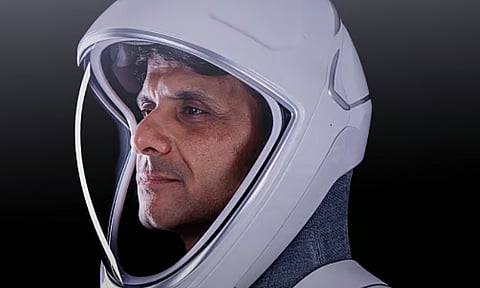

Six days after interacting with Prime Minister Narendra Modi, Group Captain and now astronaut Shubhanshu Shukla (call sign Shux) engaged with a group of curious Bengaluru students from aboard the International Space Station (ISS).
In a lively 12-minute interaction via HAM Radio — organised by Amateur Radio on the ISS (ARISS) and AMSET — Shux responded to both technical and personal questions. The session was facilitated through a telebridge contact between Bengaluru and Maryland, United States of America (USA).
The event was hosted at the UR Rao Satellite Centre, where excitement among students and faculty was evident. Their energy was mirrored by Shux, who became the first Indian astronaut to interact with Indian students from the ISS on two consecutive days.
While he had spoken to students in Thiruvananthapuram on July 3, Friday’s interaction was his first through HAM radio. A second HAM session is scheduled with students in Shillong on July 8.
Answering a question from Kavitha N, a Grade 10 student, about the most difficult part of his daily routine, Shux said, “The most difficult task on the ISS is to sleep. While you can sleep anywhere, you don’t want to because you’re only here for a short duration—just 14 days.”
He explained that although the experience is filled with excitement and a packed schedule, getting proper rest is still essential. “There’s so much going on, and we want to make the most of every moment. But rest is equally important,” he added.
Ten students from Karnataka Public School’s Domlur and Jeevan Bheema Nagar branches were handpicked to participate. They asked 13 questions that were pre-approved by ISRO, covering topics ranging from rocket launches to life in zero gravity.
Describing the difference between the capsule and the ISS, Shux noted, “The capsule was small, and we had to be strapped in most of the time. The ISS, in contrast, is big — you can move around easily. That’s both nice and a bit of a concern.”
On adjusting to microgravity, he said, “It feels very light here. With no gravity, it’s like swimming in the air. The body takes time to adapt. You’re floating up and down, and lifting heavy objects becomes effortless. Orientation becomes a challenge too, we’re not used to it.”
In response to Aryan, a Grade 9 student who asked about the rocket launch and docking, Shux said the experience was exhilarating. “The rocket launched very fast, and the higher we went, the faster it got, our velocity was 8 km per second. The first stage was fast, and the second was even faster. For the first one and a half days, while in the capsule, we were floating in free flight,” he said.
He described the docking process as “very exciting,” citing the precision with which the ISS was aligned and how the capsule entered and locked.
Asked about the most breathtaking sight from the ISS, he said, “The view of Earth is unmatched — our vantage point is incredible.”
He also touched upon the scientific experiments he is conducting, especially those involving stem cells and muscle response in microgravity, calling them the “most challenging and exciting” of his mission.
Also present at the event was Group Captain Angad Pratap, Shux’s fellow Gaganyatri crewmate. Reacting to the interaction, Pratap said, “It felt as though Shux was talking directly to me.” ISRO Chairman V Narayanan remarked that the goal of the session was to inspire students and encourage them to pursue careers in space science.
